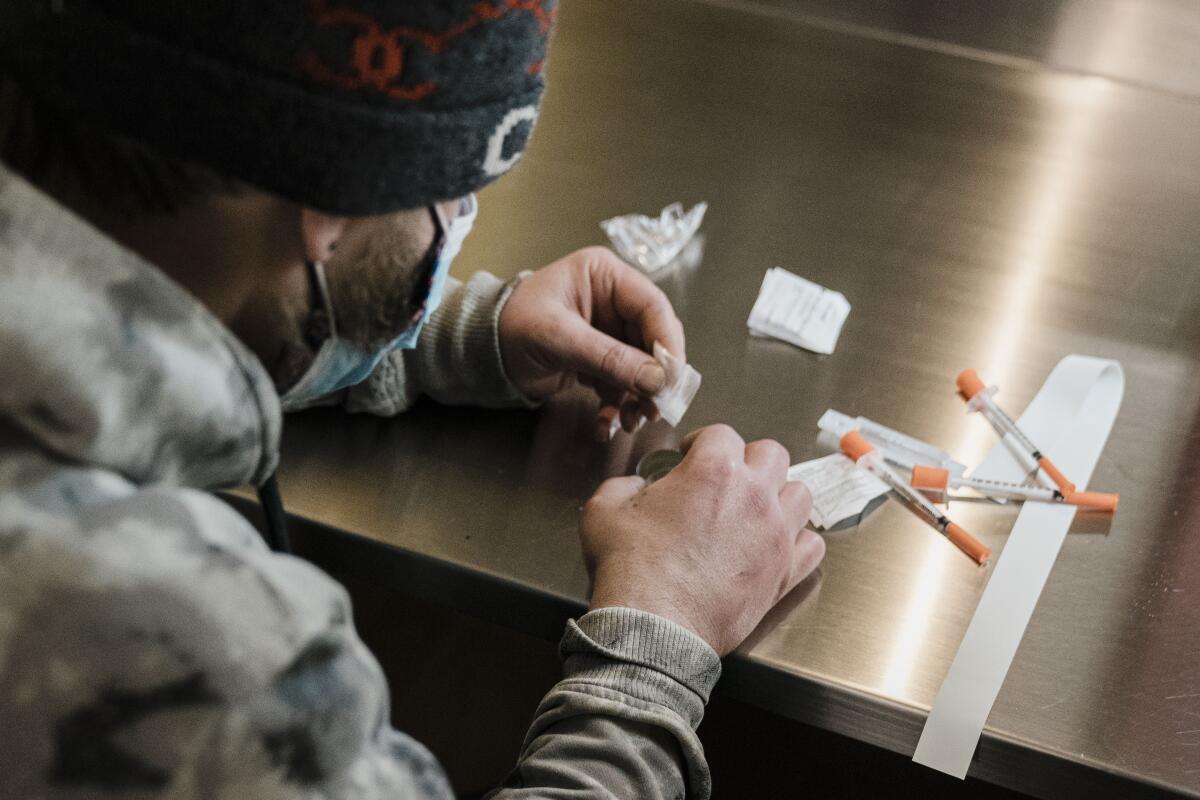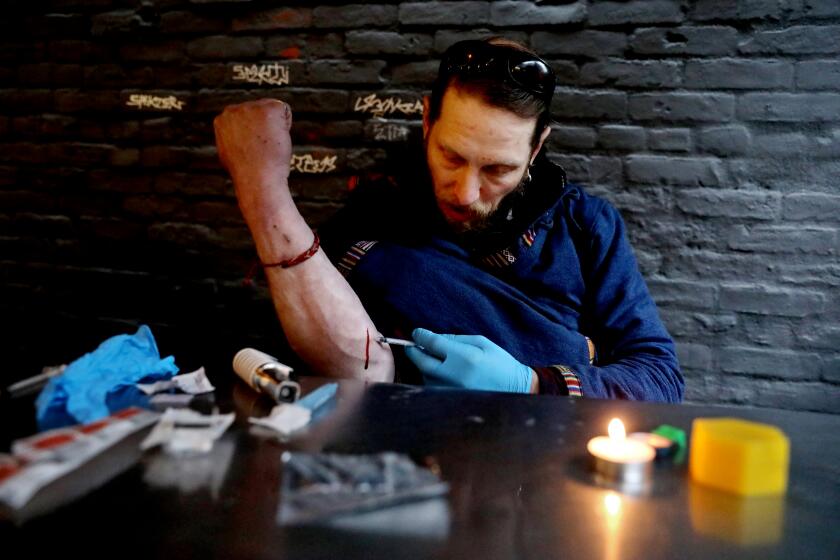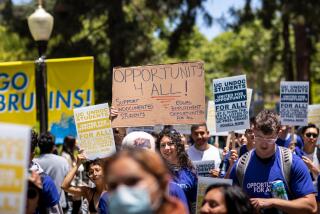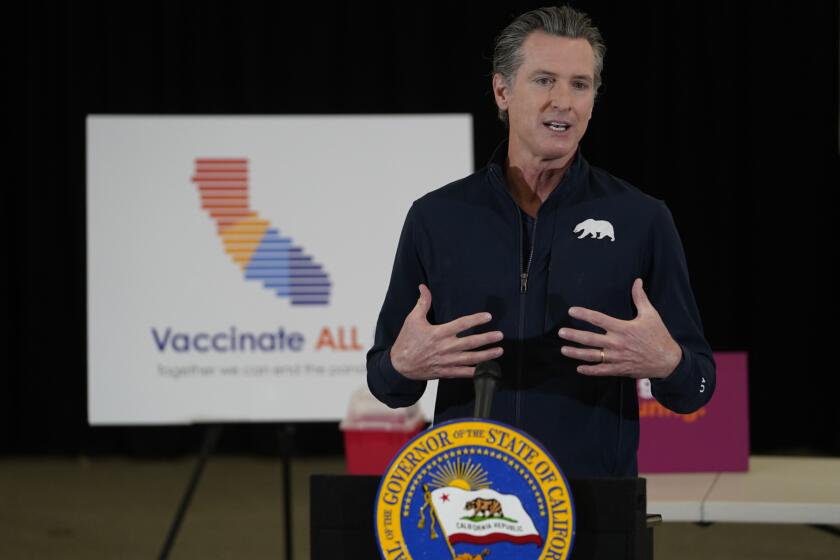Newsom vetoes bill to set up drug overdose prevention programs in some California cities

California Gov. Gavin Newsom on Monday vetoed a controversial bill that would have allowed supervised injection site pilot programs in Los Angeles, San Francisco and Oakland, in efforts to prevent drug overdose deaths and connect people to treatment for addiction.
The number of safe injection sites that would have been authorized by the bill could have induced a “world of unintended consequences,” Newsom wrote in his veto message.
“It is possible that these sites would help improve the safety and health of our urban areas, but if done without a strong plan, they could work against this purpose,” Newsom said. “These unintended consequences in cities like Los Angeles, San Francisco and Oakland cannot be taken lightly. Worsening drug consumption challenges in these areas is not a risk we can take.”
Newsom reiterated that he was committed to harm-reduction strategies, but said pilot programs need to be well planned and include strong local leadership. He said he would instruct California Health and Human Services Secretary Dr. Mark Ghaly to convene city and county officials to “discuss minimum standards and best practices” that could then be recommended to the Legislature.
“I remain open to this discussion when those local officials come back to the Legislature with recommendations for a truly limited pilot program — with comprehensive plans for siting, operations, community partnerships, and fiscal sustainability that demonstrate how these programs will be run safely and effectively,” he wrote.
Lawmakers this month sent Newsom one of the most politically challenging and closely watched proposals of the legislative session, Senate Bill 57, which state Sen. Scott Wiener (D-San Francisco) said he wrote as a way to curb overdose deaths in California through safe injection sites, also called overdose prevention programs. From the start, opponents criticized the bill as government approval to do drugs.
Gov. Gavin Newsom has vetoed a measure to open three pilot sites for safe drug consumption, putting California behind in efforts to save lives.
Newsom said he was “very, very open” to a pilot program during his bid for governor in 2018 after then-Gov. Jerry Brown vetoed similar, more narrow, legislation, which made proponents this year optimistic that Newsom would sign the bill into law. But Newsom has since faced intense criticism for California’s ballooning homelessness and drug addiction crisis, which his political critics have used as evidence of overt Democratic policy failures, especially in cities such as Los Angeles and San Francisco.
Both houses of the Legislature narrowly approved the bill, despite having a Democratic supermajority. Moderate Democrats often split with their caucus and joined Republicans in opposing the measure or abstained from voting on it.
“It’s like many pieces of legislation that are more nuanced, but trying to explain it takes four paragraphs and attacking it takes five words,” Democratic consultant Andrew Acosta said. “Politically, we live in a world that’s partisan, and people will take these things and attack them.”
State Sen. Brian Dahle of Bieber, a Republican running against Newsom for governor this year, said California hasn’t done enough to prosecute criminals who bring illegal drugs into the state, and he blamed Newsom for failing to crack down on a surge in fentanyl and other potentially lethal drugs in California.
“We need to stop the flow of drugs into our state. Thousands of people are dying,” he said. “Let’s get the drugs off our streets. Let’s get them into treatment programs, instead of making it easier or more accessible to do drugs.”
A coalition of treatment specialists, healthcare groups and civil rights organizations argued that safe injection sites would save lives by giving people with addiction a safe place to use drugs under the supervision of trained professionals, who could also make referrals for treatment. They said it would lead to cleaner streets, reduce crime and prevent the spread of HIV and hepatitis, while saving taxpayers money on ambulance calls and emergency room services.
Calls for the safe injection sites coincide with a concerning rise in opioid overdose deaths, often involving fentanyl, throughout the U.S. California recorded 6,843 opioid-related overdose deaths in 2021, according to preliminary data by the state Department of Public Health.
At least 14 countries operate close to 200 overdose prevention centers, according to the Drug Policy Alliance, an organization that advocates for the end of the so-called war on drugs. New York became the first city in the nation last year to open official sites. Within their first three weeks, the city’s two sites “averted at least 59 overdoses to prevent injury and death,” according to a December memo.
Laura Thomas, director of HIV and harm reduction policy at the San Francisco AIDS Foundation, said her organization provides a list of services, including sterile syringe access and disposal, substance use treatment and counseling. Adding overdose prevention services, Thomas said, would help link people to those readily available resources.
“The key aspect of these programs is it offers more opportunities for connection, more opportunities to welcome people in and more opportunities to reverse an overdose in the moment,” Thomas said.
“The only requirement for recovery is to be alive,” Dr. David Kan, an addiction specialist and past president of the California Society of Addiction Medicine, said during a recent news conference calling on Newsom to sign the bill. “It opens the door to have good and healthy interactions with healthcare staff to invite them to come into treatment.”
Law enforcement groups said SB 57 would only increase drug use and harm public safety. They criticized the bill as a legal way to normalize addiction without providing a strong incentive for treatment, and pointed to Brown’s veto of similar legislation in 2018 to validate their concerns. In his veto message, Brown said California didn’t have enough drug treatment programs, and he instead called for “incentives and sanctions” to effectively address the crisis.
Greg Totten, chief executive of the California District Attorneys Assn., said California should heed that warning and focus on compelling more people into treatment.
“We don’t question the good faith or the good intentions of the proponents of this bill. We just fundamentally believe it’s a very bad idea,” Totten said. “Our core view of the bill is that it is the practical equivalent of government-sponsored aiding and abetting of illegal and destructive drug use.”
Senate Republican Leader Scott Wilk of Saugus called SB 57 “one of the most dangerous pieces of legislation that I’ve seen sent to the governor.”
The measure would have come with a list of guardrails.
The proposal applied to a limited few jurisdictions that indicated interest in setting up safe injection sites — San Francisco, Oakland and the city and county of Los Angeles. The legislation would have expired in 2028, and the jurisdictions would have had to complete a study on the programs by early 2027.
The public, local law enforcement, public health officials and other affected groups were required to have an opportunity to weigh in on the programs before they’re established, and training and qualification criteria for on-site staff were baked into the bill, as well as protocols to refer people for treatment and other services.
In a statement, Wiener said California didn’t need another study or working group to determine that safe injection sites can save lives.
“Today’s veto is tragic,” he said. “While this veto is a major setback for the effort to save lives and connect people to treatment, we must not — and will not — let it end this movement. We’ll continue to fight for an end to the War on Drugs and a focus on drug use and addiction as the health issues that they are.”












